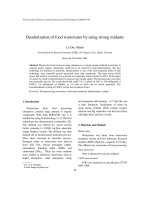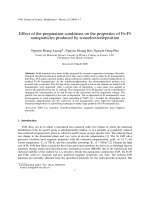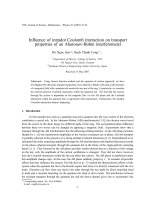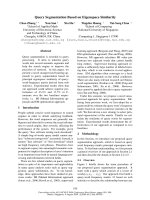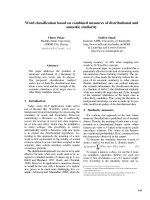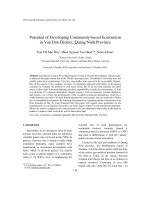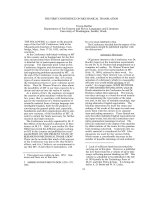Báo cáo " Security of information processing based on grid environment " pdf
Bạn đang xem bản rút gọn của tài liệu. Xem và tải ngay bản đầy đủ của tài liệu tại đây (121.32 KB, 9 trang )
VNU Journal of Science, Natural Sciences and Technology 24 (2008) 170-178
170
Security of information processing based
on grid environment
Huey-Ming Lee
1,*
, Tsang-Yean Lee
1
, Lily Lin
2
1
Department of Information Management, Chinese Culture University,
55, Hwa-Kung Road, Yang-Ming-San, Taipei (11114), Taiwan
2
Department of International Business, China University of Technology,
56, Sec. 3, Hsing-Lung Road, Taipei (116), Taiwan
.
Received 11 November 2007, received in revised form 20 November 2007
Abstract. Grid computing architecture was defined to be a complete physical layer. Based on the
grid computing architecture, we divided grid nodes into supervisor grid node and execute grid nod.
The data transfer in network must be in secure. In this study, we propose the encryption and
decryption algorithm in each grid node to keep information processing in security. We create user
information database both in supervisor and execute grid nodes. We use them to verify user
processing in system. When these algorithms install in all grid nodes, we can keep processing be
secure in all system.
Keywords: Decryption algorithm, Encryption algorithm, Grid computing, Security
1. Introduction
1
The term “Grid” was coined in the mid
1990s to denote a proposed distributed
computing infrastructure for advanced science
and engineering [1]. In grid environment, users
may access the computational resources at
many sites [2]. Lee et al. [3] proposed a
dynamic supervising model which can utilize
the grid resources, e.g., CPU, storages, etc.,
more flexible and optimal. Lee et al. [4, 5]
proposed a dynamic analyzing resources model
which can receive the information about CPU
usages, number of running jobs of each grid
_______
*
Corresponding author.
E-mail:
node resource to achieve load-balancing and
make the plans and allocations of the resources
of collaborated nodes optimize.
In general, the functions of security system
are security, authenticity, integrity, non-
repudiation, data confidentiality and access
control [6-9]. Rivest et al. [10] proposed public
cryptosystem. McEliece [11] used algebraic
coding theory to propose public key. Merkle
[12] presented “One way hash function” and
used for digital signature. Miyaguchi [13]
developed the fast data encipherment algorithm
(FEAL-8). All of these are encryption
algorithm. Lee and Lee [14] used the basic
computer operations, such as insertion, rotation,
transposition, shift, complement and pack, to
design encryption and decryption algorithm.
Huey-Ming-Lee et al. / VNU Journal of Science, Natural Sciences and Technology 24 (2008) 170-178
171
In this paper, we propose the method to
send information to other execute grid nodes
through supervisor grid node. Supervisor
checks the user to do the processes. We also
propose encryption algorithm to encrypt
information to produce cipher text and send it
to supervisor. Supervisor uses sender format
code to decrypts the cipher text to produce
information. Once supervisor has checked, it
uses received format code to encrypt
information to produce cipher text and sends to
the received execute grid node. The received
execute grid node uses decryption algorithm to
produce original information. Via the proposed
algorithms, we can receive and send
information in secure in network transmission.
2. Propose method description
The information is sent from one execute
grid node to other execute grid node. We send
information to supervisor grid node to check
and verify. When it is correct, we send
information to received executed grid node. The
information is encrypted to produce cipher text
and to be sent. When cipher text has received,
we decrypt to produce original information. We
explain the processes as follows.
2.1. Execute grid node
In the execute grid nodes, they have the
following operations to do:
1) Sign on procedure first time
When the execute grid node signs on first
time, it uses default format code to encrypt
user-id and password and sends to supervisor
grid node. It receives format code from
supervisor and saves to create EUIDB (Execute
User Information Data Base). The contents of
EUIDB are as Table 1.
Table 1. EUIDB (Execute User Information Data
Base)
User-id Password Format code
When user wants to send information, it
uses format code in EUIDB to encryption user-
id and password. When supervisor returns
correct, it can send information to users.
2) Request permission from supervisor
When he wants to send information to other
users, he inputs user-id and password to get
permission from supervisor. We use format
code in EUIDB to encrypt password and send
to supervisor to process.
3) Change password
When user wants to change password, he
inputs user-id, old password and new password.
We use format code in EUIDB to encrypt
password and send to supervisor to process.
4) Delete user
When user wants to delete entry in
supervisor, he inputs user-id and password. We
use format code in EUIDB to encrypt password
and send to supervisor to process and delete the
entry in EUIDB.
5) Send information to user in other execute
grid node
When he wants to send information to other
user, he types user-id, received-user-id and
information. We use format code in EUIDB to
encrypt received-user-id and information to
produce cipher text and send to supervisor to
process.
6) Receive information from supervisor grid
node
When it receives cipher text from
supervisor, it uses format code to decrypt cipher
text to get information.
Huey-Ming-Lee et al. / VNU Journal of Science, Natural Sciences and Technology 24 (2008) 170-178
172
7) Exit from supervisor grid node
When user wants to log out, it sends user-id
to supervisor.
2.2. Supervisor grid node
In the supervisor grid node, it handles
information processing. It has following
operations to do.
1) Receive new user sign on
When the new user signs on, it receives
cipher text. It uses default format code to
decrypt cipher text to get user-id and password.
It uses user-id as key to access supervisor user
information data base. If user exists and returns
error code, otherwise he assigns a format code
to user and creates an entry in the SUIDB
(supervisor user information data base) as Table
2 and return format code. It creates an entry in
the RUIDB (running user information data
base) and inserts access time as Table3.
Table 2. SUIDB (Supervisor User Information Data
Base).
User-id Password Format code
Table 3. RUIDB (Running user information data
base).
User-id Password Format
Code
Access
Time
2) Receive user request
It receives the cipher text and uses use-id as
key to find the format code in the SUIDB. If the
user does not exist, it returns error code. It uses
this format code to decrypt cipher text to get
password. When the password is not the same
as in SUIDB, it returns error code and exits. It
creates an entry in the RUIDB and returns
permission to access.
3) Receive information
When it receives the cipher text of
information, it uses user-id as key to find the
format code in the RUIDB. If the user-id does
not exist, it will return error code and exist. It
uses the format code to decrypt cipher text to
find received-user-id and information. It uses
receive-user-id as key to find the format code of
this received-user-id. If the user does not exist,
it will return error code to user of sender and
exit. It uses format code of received-user-id to
encrypt user-id and information to produce
cipher text. It sends the cipher text to received-
user-id. We update access time field in RUIDB.
4) Receive return message from receive
user
When it receives return message from
received-user-id, it uses the user-id as key to
find the format code and decrypt to find original
user-id and message. It uses the format code of
original user-id to encrypt message to produce
cipher text and return to original user. We
update access time field in RUIDB.
5) Force to process sign out
When user does not process a periodical
time, supervisor releases the entry in RUIDB.
3. Framework of the proposed model
In this section, we present the framework of
the proposed security of information process
model based on grid environment. Based on the
grid computing architecture, we divide grid
nodes into supervisor grid node (S0) and
execute grid node (Xi). We also present the
supervisor information process module (SIPM)
on the supervisor grid node, execute
information process module (EIPM) on the
execute grid node, as shown in Fig. 1.
Huey-Ming-Lee et al. / VNU Journal of Science, Natural Sciences and Technology 24 (2008) 170-178
173
Fig. 1. Framework of the proposed model.
3.1. Supervisor grid node
We present the supervisor information
process module (SIPM) on the supervisor grid
node. The components in this module are
shown in Fig. 2.
The functions of these components are as
the follows:
1) Supervisor receive information
component (SRIC):
SRIC receives information from the execute
grid node. It calls information decryption
component (IDC) to decrypt cipher text to get
information. Calls SPIC (Supervisor Process
Information Component).
2) Supervisor process information
component (SPIC):
SPIC processes the request of execute grid
nodes. We have the following actions.
(1) Type N. Use user-id as key to check
SUIDB (Supervisor User Information Data
Base). If user-id exists, it will return error code
and exit. If user-id does not exist, it creates an
entry with user-id, password and new format
code in SUIDB and returns format code. We
create an entry in RUIDB (Running User
Information Data Base) as Table 3.
(2) Type P. We check user-id and password
in SUIDB. If it is not correct, it returns error
code and exits. We create an entry in RUIDB.
(3) Type U. We check user-id and password
in SUIDB. If it is not correct, it will return error
code and exit. We change password in SUIDB
and store new format code and return format
code. We create an entry in RUIDB.
(4) Type D. We check user-id and password
in SUIDB. If it does not correct, it will return
error code and exit. We delete user-id in
SUIDB and return message.
(5) Type E. We delete the entry in RUIDB
(6) Type S. We use received-user-id as key
to check in SUIDB. If it does not exist, it will
return error code and exits. It uses format code
of received-ser-id to call IEC to encrypt
information to produce cipher text and send to
received-user-id.
In each process, we change connect time in
RUIDB when required and write the text to log
file.
Supervisor Information Process
Module (SIPM)
Supervisor Grid Node
(S
0
)
Execute Grid Node
(
X
i
)
Execute Information
Process Module
(EIPM)
Execute Grid Node
(X
j
)
Execute Information
Process Module
(EIPM)
Proposed Model
User / Grid
Information
Huey-Ming-Lee et al. / VNU Journal of Science, Natural Sciences and Technology 24 (2008) 170-178
174
Fig. 2. Architecture of the SIPM.
3) Supervisor check active node component
(SCANC):
SCANC processes periodically. If user does
not connect for a period, supervisor deletes the
entry in URIDB.
4) Supervisor send information component
(SSIC):
SSIC sends information to grid node.
3.2. Execute grid node
We present the execute information process
module (EIPM) on the execute grid node in this
section. The components in this module are
shown in Fig. 3.
The functions of these components are as
the follows:
1) Execute receive information component
(ERIC):
ERIC receives information. If it receives
from supervisor, it calls EPSIC (Execute
Process Supervisor Information Component),
otherwise it calls EPUIC (Execute Process User
Information Component).
2) Execute process user information
component (EPUIC):
EPUIC processes to send user information
to supervisor. It has the following formats.
(1) First time sign on. Set code as N and
type user-id and password.
(2) Request permission. Set code as P and
type user-id and password.
(3) Change password. Set code as U and
type user-id, old password and new password.
(4) Send information. Set code as S and
type user-id, received-user-id and information.
(5) Exit. Set code E and type user-id to exit
from supervisor.
In (1), we use default format code. In (2) to
(4), we get format code in EUIDB (Execute
User Information Data base). We call IEC
(Information Encryption Component) to
encryption information to produce cipher text.
Then call ESIC.
3) Execute process supervisor information
component (EPSIC):
EPSIC calls IDC. IDC uses format code to
decrypt cipher text to get information. From the
receive code, it has following process.
(1) Code N. Receive format code and store
to EUIDB (Execute User Information Data
Base).
(2) Code P. Receive permission from
supervisor.
(3) Code R. Receive return code from
supervisor.
(4) Code S. Receive information from
supervisor. This information comes from other
user and returns message to user.
SRIC
SPIC
SSIC
Execute Grid Node
(X
i
)
Execute Grid Node
(X
k
)
U
ser /
G
rid
Information
IDC
IEC
SUIDB
LG
URIDB
SIPM
SCA
NC
Huey-Ming-Lee et al. / VNU Journal of Science, Natural Sciences and Technology 24 (2008) 170-178
175
Fig. 3. Architecture of EIPM.
4) Execute send information component
(ESIC):
Execute send information component
(ESIC) sends information or return code to
supervisor.
4. Encryption and decryption algorithm
4.1. Encryption algorithm (IEC Information
encryption component)
The information has the following format as
Table 4.
Table 4. Information
Code User-id Information
Information has different fields separated
by comma. After processes the encryption, we
produce the following format as Table 5 to send
out.
Table 5. Information send out
Code User-id Cipher Text
We use the basic computer operations to
design this algorithm. We explain each
encryption step in Section 4. We let the length
of information to be N and it is plaintext.
1). Encryption step
The encryption steps are as follows:
(1) Build the tables. The steps are as
follows:
Step 1: Store plaintext to symbol table.
From plaintext, we set symbol table ST as N to
store plaintext.
Step 2: Set shift count to SC. SC is 1 to 7.
We left shift every byte of ST to SC places. We
set SC to SC+32.
Step 3: Insert M dummy symbol to trail of
ST. We get any M (=INT (N/10)+1) dummy
symbol and insert to the trail of symbol table.
The length of symbol table is N+M.
Step 4: Set rotate byte and rotate symbol
table. Get any character DD
1,
DD
2
. Set rotated
byte RB
1
, as RB
1
= DD
1
mode ((N+M)/2) and
RB
2
= DD
2
mode ((N+M)/2). We divide ST into
two equal parts, saying SP1 and SP2, lengths of
SP1 SP2 are equal or length (SP1)=length
(SP2)+1. We rotate SP1 to left RB
1
times and
rotate SP2 to right RB
2
times. Insert RB
1
,
RB
2
to
the trailer of combination of new SP1 and SP2.
Get symbol table after rotation (STAR).
EIPM
ERIC
ESIC
Supervisor Grid Node
(S
0
)
U
ser//
Supervisor
Information
ESIC
IDC
IEC
EUIDB
EPSIC
Huey-Ming-Lee et al. / VNU Journal of Science, Natural Sciences and Technology 24 (2008) 170-178
176
Step 5: Complement the symbol table after
rotation. Set control bit table (CBIT) to all 0
and byte length to L= [(N+M+2)/8+1]. If the
value of STAR is below the certain value (ex.
20
16
), we complement the symbol of STAR to
get symbol table after complement (STAC) and
set the relative bit of CBIT to 1.
Step 6: Packed control byte table. To form
control byte table (CBT), we take each 7 bits
(as eeeeeee) of CBIT from left and set control
byte as eee1eeee. The length of CBT is
K=[(N+M+2)/7] +1.
(2) Build background symbol table (BST)
Step 1: Reserve table
Set S to format code. We set number
L=2*N+S. We reserve table size as L.
Step2: Set value of table. Set above table as
random value between 20
16
to F0
16
(3) Build cipher text
We have STAC (symbol table after
complement), CBT (control byte table), SC, N,
M, and K.
From format code, we store SC, STAC and
CBT to BST and BST is cipher text.
2). Format code
We may define some value of format code
as showing Table 6.
3). Message format
The format of sending message has fields as
Code, User-id and cipher text.
4). Algorithm description
In this algorithm, we have solved the
following items.
(1) Data uncertainty;
(2) Brute-force by volume of data to send;
(3) Change contents of plaintext;
(4) Network transmission;
(5) Simple computation.
5). Combination possibility
Encryption Step
Times of
Combination
(1) Shift the symbol table 8**(N)
(2) Insert dummy symbol 256**M
(3) Set rotate byte and rotate
( (N+M)/2)**2
(4) Complement the STAR 2**(N+M+2)
(5) Packed 2**7*(INT ((N+M+1)/7)+1)
(6) Reserve Table 240**(0.7N)
(7) Format code 240
The total possible combinations are
8**(N)*256**M*(N+M)*
( (N+M)/2)**2**2**(N+M+2)
*2**7*(INT((N+M+1)/7)+1)*240**(0.7N)*240
This number is large. It is difficult to
decrypt.
4.2. Decryption algorithm (IDC Information
Decryption Component)
Decryption is the reversed order of
encryption. Before decryption, we should know
the values S of format code in execute user
information data base and U (length of user-id
+1 (Code)). We get the L (length of message).
We can compute the length of tables as follows
Table 6. Contents of format code and cipher text.
Format Code Cipher text Content
1 SC,STAC,CBT
2 SC, dd, STAC, dd, CBT
3 STAC, SC, CBT
… ….
>127 Store in reverse order
where dd is the character skipped.
The length of symbol table N=1/2*(L-S-U).
Huey-Ming-Lee et al. / VNU Journal of Science, Natural Sciences and Technology 24 (2008) 170-178
177
The length of dummy symbol M=
INT(N/10)+1.
The length of CBT K=[(N+M+2)/7] +1.
From different format code and above
values, we can get SC, STAC and CBT.
1) The steps of decryption algorithm are as
follows:
Step 1: Get from cipher text (CT). We get
N, M, K, SC, STAC and CBT.
Step 2: Pack control bit table (CBIT). We
retrieve 7 bits (skip the 5
th
bit from left of each
byte) from each CBT. We pack above bits to
form the CBIT and length L=[(N+M+2)/8]+1.
Step 3: Complement symbol table after
complement (STAC). From each bit of CBIT, if
the value of relative bit is 1, we complement the
corresponding byte of STAC and get symbol
table after rotation (STAR).
Step 4: Rotate symbol table after rotation
(STAR). Get rotated byte RB
1
=STAR
N+M+1
and
RB
2
= STAR
N+M+2.
We divide first N+M
symbols of STAR to two equal parts, saying
SP1 and SP2, lengths of SP1 and P2 are equal
or length (SP1) =length (SP2) +1. We rotate
SP1 to right RB
1
times and rotate SP2 to left
RB
2
times. We combine SP1 and SP2 to get
symbol table after shift (STAS).
Step 5: Shift the symbol table after shift
(STAS). Set SC=8-(SC-32). We left shift each
byte of first N bytes of STAS and get the
plaintext. This is the original plaintext.
5. Conclusion and discussion
In this study, we use the basic computing
operations to design the encryption and
decryption algorithms. It doesn’t need any
special hardware. Finally, we make some
comments about this study.
a) To do the encryption, we must know
format code to produce cipher text.
b) Each cipher text may have different
length and format because it has different
format code and the length of dummy symbol
table.
c) To do decryption, we must know format
code, shift count and different format to decrypt
cipher text to plaintext.
d) The proposed algorithm in this study is
more difficult to cryptanalysis, because the
following fields of each transaction have
different value in the cipher text.
(a) format code, (b) shift count, (c) rotation
(d) background table of random data.
e) Message processes through encryption
and decryption are more secure.
f) Give permission from supervisor and do
information process.
Acknowledgements. This work was
supported in part by the National Science
Council, Republic of China, under Grant NSC-
96-2745-M-034-002-URD.
References
[1] I. Foster, C. Kesselman, S. Tuecke, “GRAM: Key
concept”, Available: http://www-
unix.globus.org/toolkit/
docs/3.2/gram/key/index.html, July 31, 1998
[2] I. Foster, C. Kesselman, “Globus: A Metacomputing
Infrastructure Toolkit”, International Journal of
Supercomputer Application Vol. 11 No. 2 (1997)
115.
[3] H.M. Lee, C.C. Hsu, M.H. Hsu, “A Dynamic
Supervising Model Based on Grid Environment”,
Knowledge-Based Intelligent Information &
Engineering Systems, LNCS 3682, Springer-Verlag,
(2005) 1258.
[4] H.M. Lee, T.Y. Lee, C.H. Yang, M.H. Hsu, “An
Optimal Analyzing Resources Model Based on Grid
Environment”, WSEAS Transactions on Information
Science and Applications, Issue 5, Vol. 3 (2006) 960.
[5] H.M. Lee, T.Y.Lee, M.H. Hsu, “A Process Schedule
Analyzing Model Based on Grid Environment”,
Knowledge-Based Intelligent Information &
Engineering Systems, Part III, LNAI 4253, Springer-
Verlag, (2006) 938.
[6] E. Biham, A. Shamir, “Differential Cryptanalysis of
DES-like Cryptosystem”, Advances in Cryptology-
Huey-Ming-Lee et al. / VNU Journal of Science, Natural Sciences and Technology 24 (2008) 170-178
178
CRYPTO ’90 Proceedings, Berlin: Springer-Verlag,
(1991) 2.
[7] E. Biham, A. Shamir, “A Differential Cryptanalysis
of the Data Encryption Standard”, Springer, Berlin
Heidelberg New York, 1993
[8] E. Biham, A. Shamir, “Differential Cryptanalysis of
Data Encryption Standard”, Berlin: Springer-Verlag,
1993.
[9] W. Stallings, “Cryptography and Network Security:
Principles and Practices”, International Edition,
Third Edition 2003 by Pearson Education, Inc. Upper
Saddle River, NJ 07458.
[10] R.L. Rivest, A. Shamir, L. Adleman, “A Method for
Obtaining Digital Signatures and Public –Key
Cryptosystems”, Communications of the ACM, Vol.
21 No. 2 (1978) 120.
[11] R.J. McEliece, “A Public-Key System Based on
Algebraic Coding Theory,” Deep Sace Network
Progress Report, 44, Jet Propulsion Laboratory,
California Institute of Technology (1978) 114.
[12] R.C. Merkle, “One Way Hash Function and DES,”
Proc. Crypto’89, Berlin Springer-Verlag (1990) 428.
[13] S. Miyaguchi, “The FEAL-8 Cryptosystem and Call
for Attack,” Advances in Cryptology-CRYPTO’89
proceedings, Springer-Verlag (1990) 624.
[14] T.Y. Lee, H.M. Lee, “Encryption and Decryption
Algorithm of Data Transmission in Network
Security”, WSEAS Transactions on Information
Science and Applications, Issue 12, Vol. 3 (2006)
2557.
